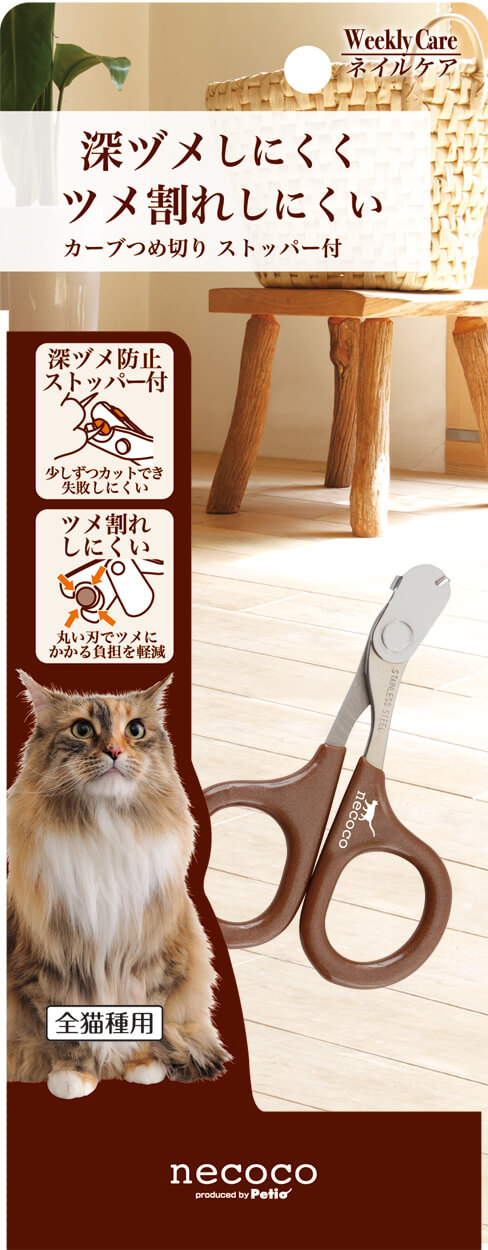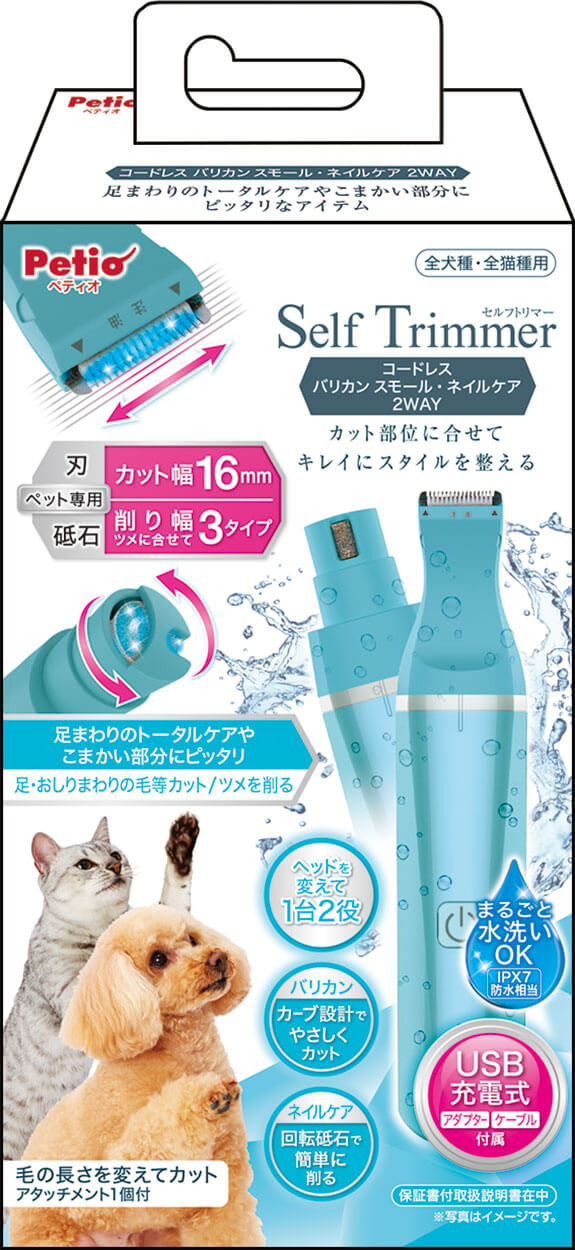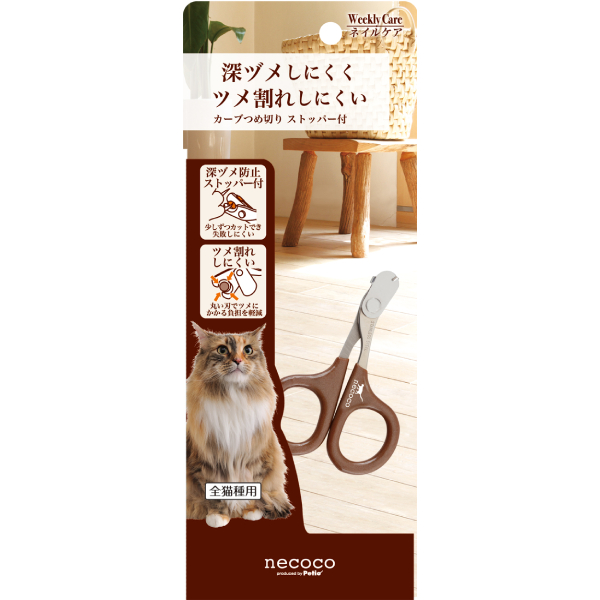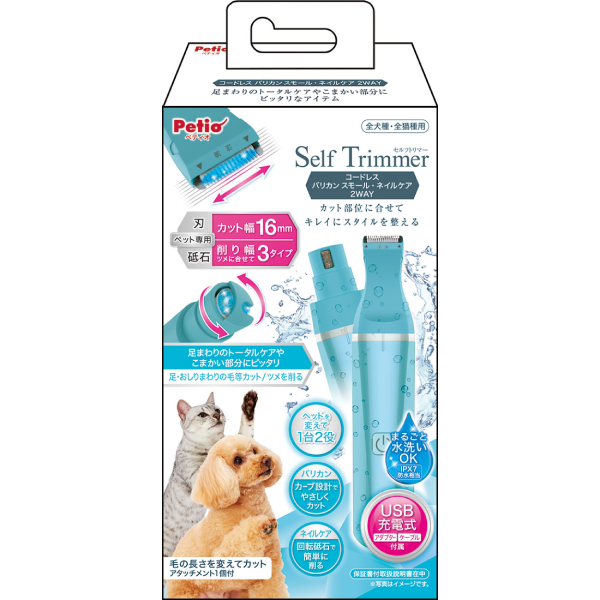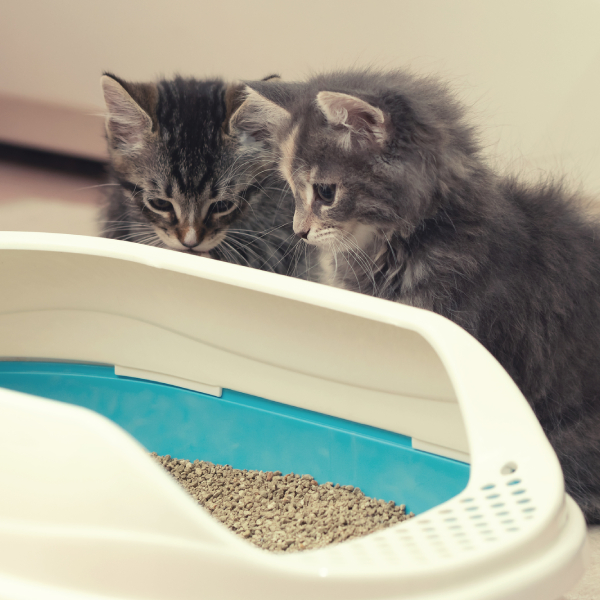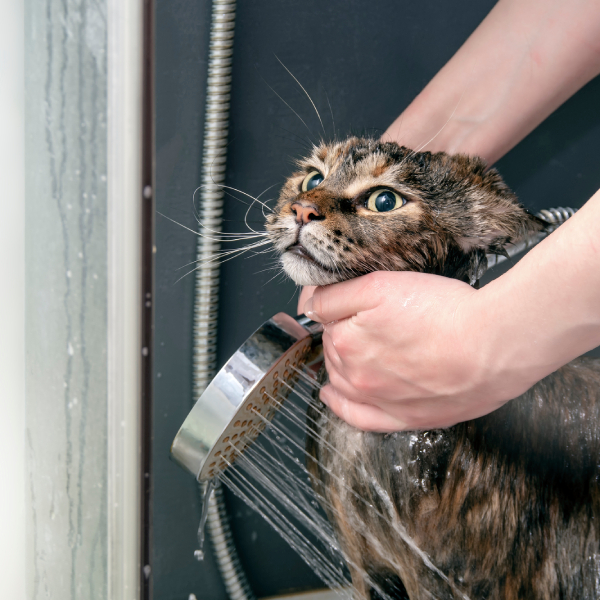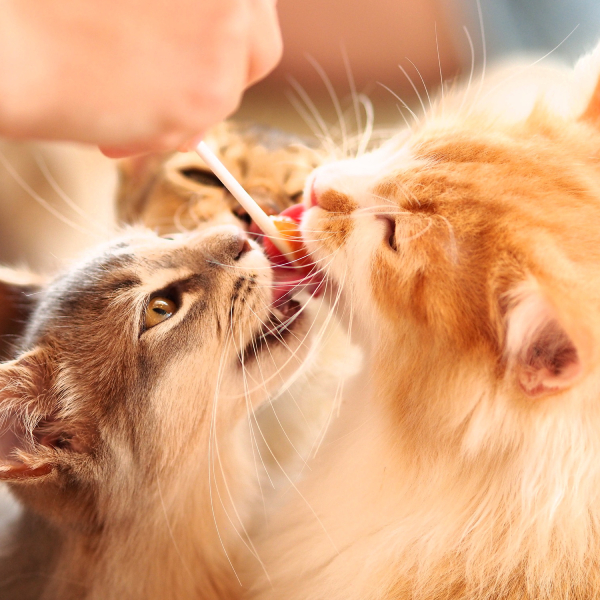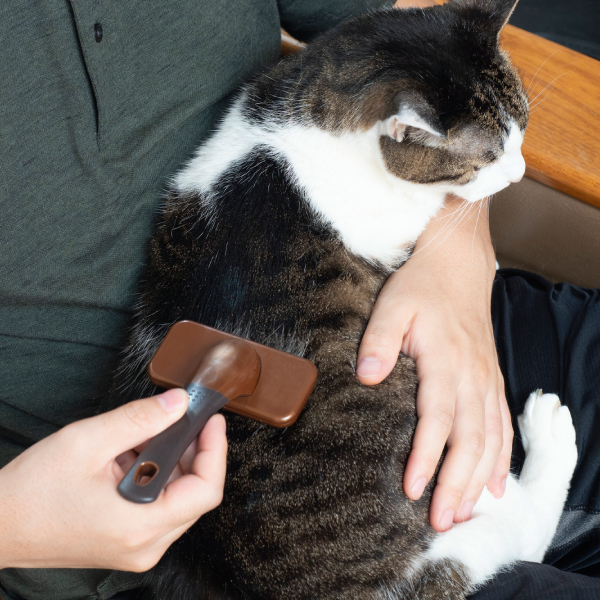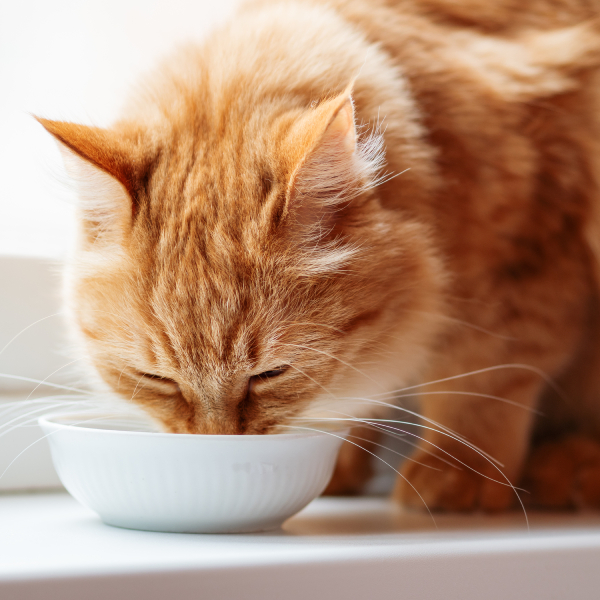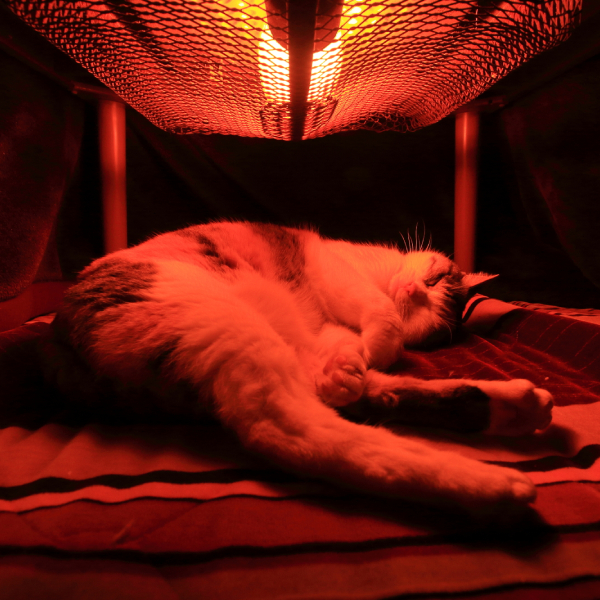特集/Pickup
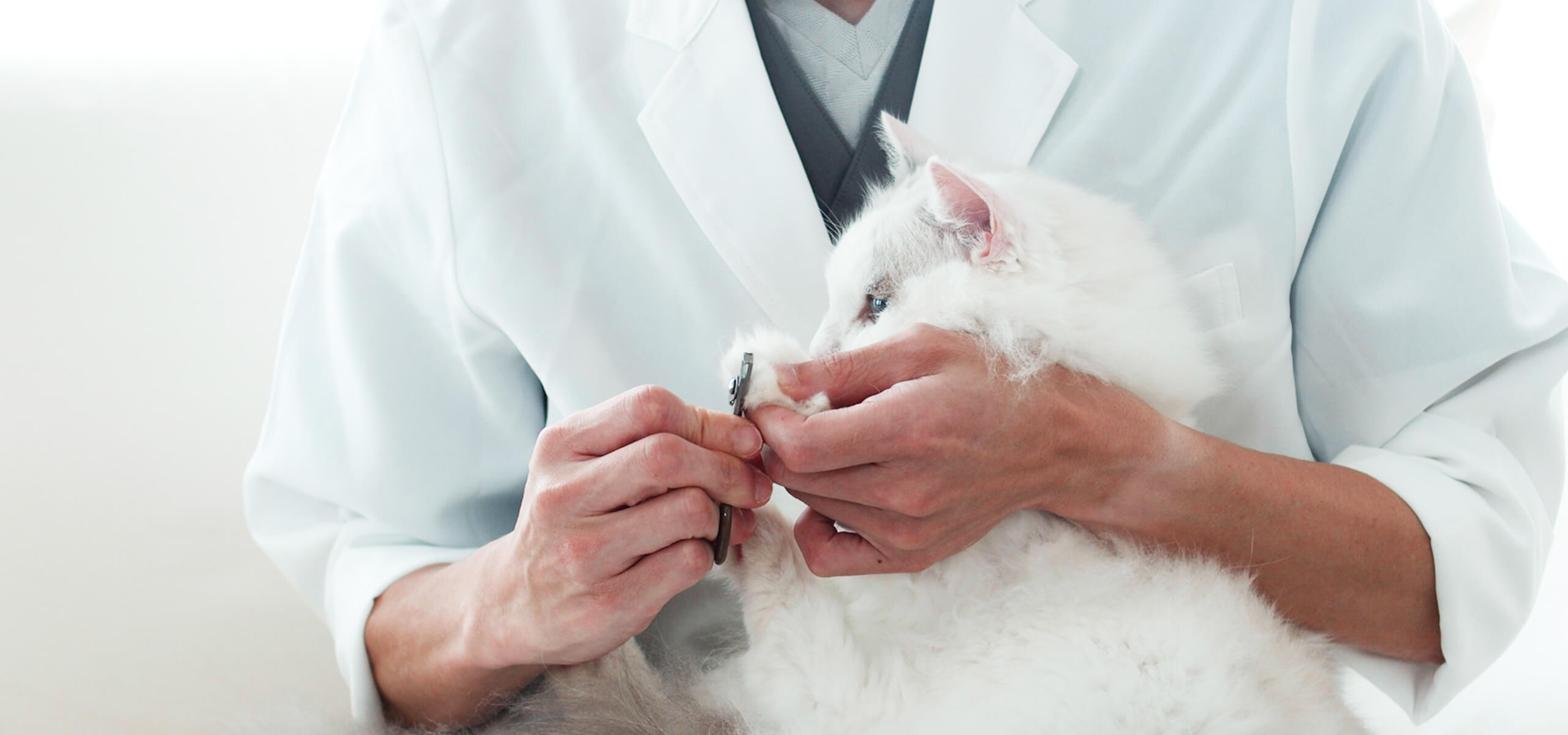
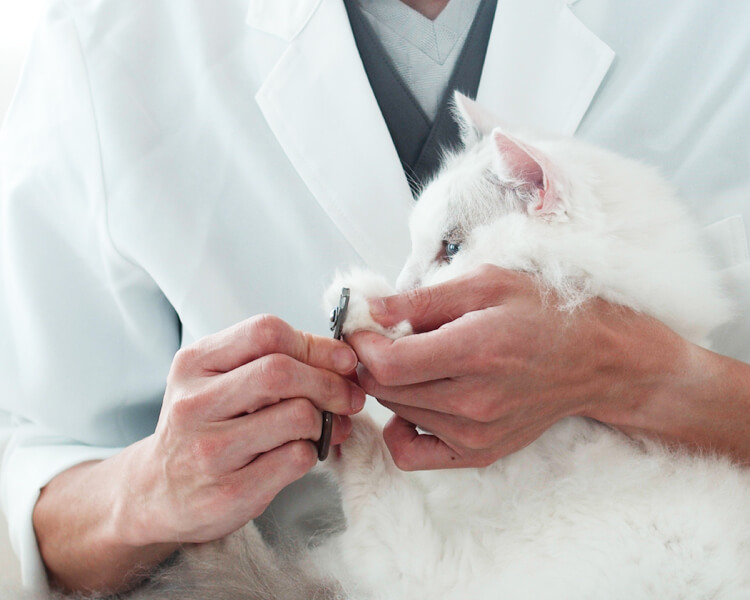
ここでは、猫の爪切りを上手に行うためのポイントや、おすすめのグッズをご紹介します。(最終更新日2023年3月31日)

監修
静岡県島田市向谷3-918-9
TEL 0547-33-6010
北里大学獣医学部獣医学科卒業。専門学校ルネサンス・ペット・アカデミー非常勤講師、日本ペットマッサージ協会とペット薬膳国際協会の講師を務める。東日本大震災における被災動物レスキュー活動などにも参加。一般的な西洋医療のほか、鍼灸治療や漢方、ペットマッサージなどを通して動物の健康に取り組む。
1【まずは動画で解説!】獣医が教える!猫の爪切りの方法
猫の爪切りはどのように行うのがよいのでしょうか。
手順や押さえておくべきポイントなどを動画にまとめましたので、まずはこちらをご覧ください。
2そもそも猫って、爪切りをする必要あるの?
猫は、爪を自分の意志で出し入れできる動物です。狩りをしたり木に登ったりするときには爪を出し、獲物を狙って近づくときには爪を引っ込めて、足音を忍ばせています。
外で生活をしている猫は、自在に爪を操って行動しますので、爪が自然と削れていき、適度な長さに保たれます。しかし、室内飼いの猫はそのままにしていると爪が尖り、結果的には爪が伸びすぎてしまうのです。
「猫は自分で爪とぎをするから爪切りはしなくてもいいのでは?」と、考える方もいるかもしれません。しかし、爪切りと爪とぎはそもそも違います。
猫の爪は玉ねぎのような層状になっています。古くなった爪の層をはがして新しい爪を前面に出す行為が爪とぎなのです。ですから、爪とぎをしても爪自体の長さや鋭さはそのままになります。
猫の爪の長さを適正に保ち、尖った部分を整えるためにも、定期的な爪切りケアが必要なのです。
3猫の爪を伸ばしっぱなしにするとどうなる?
室内飼いの猫の爪を伸ばしっぱなしにすると、猫にとっても飼い主にとっても不都合が生じることが多くなります。具体的にどのような不都合が生じるのか、見ていきましょう。
飼い主や同居の猫を傷つけてしまうおそれがある
猫の爪切りをせずに爪が伸びっぱなしで鋭いままにしておくと、飼い主にじゃれつく、ひざに飛び乗るなど、ちょっとした行為で爪が引っかかり、飼い主がケガをしてしまうことがあります。また、多頭飼いの場合、同居の猫同士のじゃれ合いや喧嘩の際に、猫同士が互いにケガをしてしまうおそれもあります。
また、ケガではありませんが、家の中の壁や家具が猫の爪によって傷つけられてしまうというリスクも考えられます。
飼い主が病気に感染するリスクがある
爪に特定の菌があった場合、引っかき傷だけでは済まず、人が「猫ひっかき病(バルトネラ症)」や「パスツレラ症」といった感染症にかかるリスクもあります。
猫ひっかき病は、バルトネラ菌により引き起こされる病気です。症状としては、傷口の化膿や発熱、リンパ節の腫れなどが挙げられます。場合によっては、倦怠感や頭痛、喉の痛みや発熱を伴うこともあります。
また、パスツレラ症は、パスツレラ菌によって起こる病気です。猫に引っかかれたり、噛まれたりした所が腫れて赤くなるのが主な症状ですが、お年寄りや糖尿病といった基礎疾患を持つ抵抗力の弱い方などは、重症化して命に関わる危険性もあります。
いずれの菌も、猫は保菌していても症状はありません。ただし、人が感染してしまうと症状が出るものなので、注意が必要です。
猫自身も危険な状況に陥る場合がある
爪切りをせず爪が伸びたままでいると、猫自身にも危険が及ぶことがあります。爪が不自然に折れたり割れたりするばかりでなく、伸びた爪が家具やカーテン、カーペットなどに引っかかって、爪を折ってしまうこともあるでしょう。根元から折れて出血する、大ケガにつながってしまうケースもあるため、十分な注意が必要です。
また、爪が伸びすぎて巻き爪状態になり、肉球に刺さってしまうと、そこから化膿してしまうおそれもあります。猫の肉球はデリケートな場所です。そのままにしていると強い痛みを感じたり、うまく歩けなくなったりしてしまいます。
高齢の猫や爪とぎをあまりしない猫は、爪が太くなってしまうおそれがある
高齢の猫は睡眠時間も長くなり運動量が少なくなるため、爪が伸びるのが緩やかになる傾向にあります。とはいえ、爪とぎの頻度が減ることもあるようなので、古い爪が完全にはがれず、結果的に爪が太くなってしまう猫もいます。
爪とぎをあまりしない猫も同様に、爪が太くなってしまう場合が多いです。太く伸びすぎた爪は肉球に刺さりやすくなってしまいます。そのため、こまめにチェックして爪のケアをしてあげることが必要です。
4猫の爪切りのためにそろえたい必要な物
続いては、猫の爪切りをするために必要な物をご紹介します。全部そろえなければならないというわけではありませんが、猫の状態に応じて準備してみてください。


猫専用の爪切り
猫の爪切りには、猫専用の爪切りを使用しましょう。人用の爪切りだと、爪が不自然に割れてしまったり、猫が痛がったりすることがあります。
猫用の爪切りには、ハサミタイプとギロチンタイプの2種類があります。
・ハサミタイプ
ハサミタイプの爪切りは、文房具のハサミと同じ構造なので、初めて猫の爪切りをする方にも抵抗なく使用できるかもしれません。深爪防止のためのストッパーがついている爪切りもあり、コンパクトな形状をしているのも特徴です。
刃先が半円状にくぼんでいますので、そのカーブ部分に沿って爪をあて、ハンドルを動かしてカットします。ただし、切断する力はあまり強くはないので、爪が硬めの成猫の爪を切る際には注意しましょう。
・スライドカッター(ギロチンタイプ)
スライドカッター(ギロチンタイプ)の爪切りは、ギロチンの穴に爪を通して、ハンドルを握ることでひと息に爪を切ることができます。ギロチンの切断する部分に均等に力がかかるので一瞬でスパッと切れて、爪が割れにくいのも特徴です。
しかし、ギロチンの穴が成猫に合わせたサイズとなっているため、子猫の爪だと深爪にしてしまうおそれがあります。また、古い爪が残り、太くなってしまった爪や巻き爪は、穴に通らないこともあるので注意が必要です。
猫がお気に入りのご褒美
猫のお気に入りのフードやおやつ、おもちゃなどを用意しておくといいでしょう。爪切りを始める前に猫を落ち着かせたいときや、爪切り後のご褒美をあげたいときに有効です。
猫を保定するための洗濯ネットなど
猫が爪切りを嫌がり、暴れてしまうと爪が切りにくいばかりでなく、深爪やケガの原因になります。猫を落ち着かせる、あるいは保定して動きにくくさせるために洗濯ネットや大きめの布の袋、バスタオルなどを用意しておきます。場合によっては、円錐台形状の保護具である猫用のエリザベスカラーを使用してもいいかもしれません。比較的網目の大きな洗濯ネットを使うことで、猫が洗濯ネットに入った状態で爪を切ることも可能です。
いずれにしても、猫の状態を確認し、使用する物や方法を選ぶようにしましょう。
止血のための清潔なガーゼやコットン
清潔なガーゼやコットンを用意しておきましょう。もし、血管を切ってしまい、出血してしまった場合でも、すぐに止血できるようにするためです。
5猫の爪切りをうまく行う方法とは?
爪切りのためのグッズが用意できたら、いよいよ猫の爪切りを行います。落ち着いて、下記の手順どおりに行ってみてください。

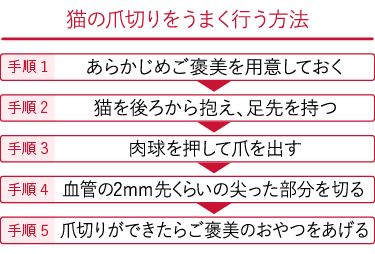
1. あらかじめご褒美を用意しておく
猫のお気に入りのフードやおやつ、おもちゃなどを用意し、猫の気をそらします。
2. 猫を後ろから抱え、足先を持つ
猫を後ろから抱え、自分のひざの上に乗せます。その後、利き手の反対の手で足先を持ちます。順番としては、一般的には後ろ足からのほうがやりやすいです。このとき、しっかり押さえつけてしまうと、猫が嫌がって爪切りを嫌いになってしまう可能性があります。そのため、爪切り中はなるべく、猫がリラックスできるような姿勢を試してみましょう。
3. 肉球を押して爪を出す
足先を持った手で肉球を押し、隠れている爪を出します。このときも、肉球を強く押しすぎないように注意しましょう。
4. 血管の2mm先くらいの尖った部分を切る
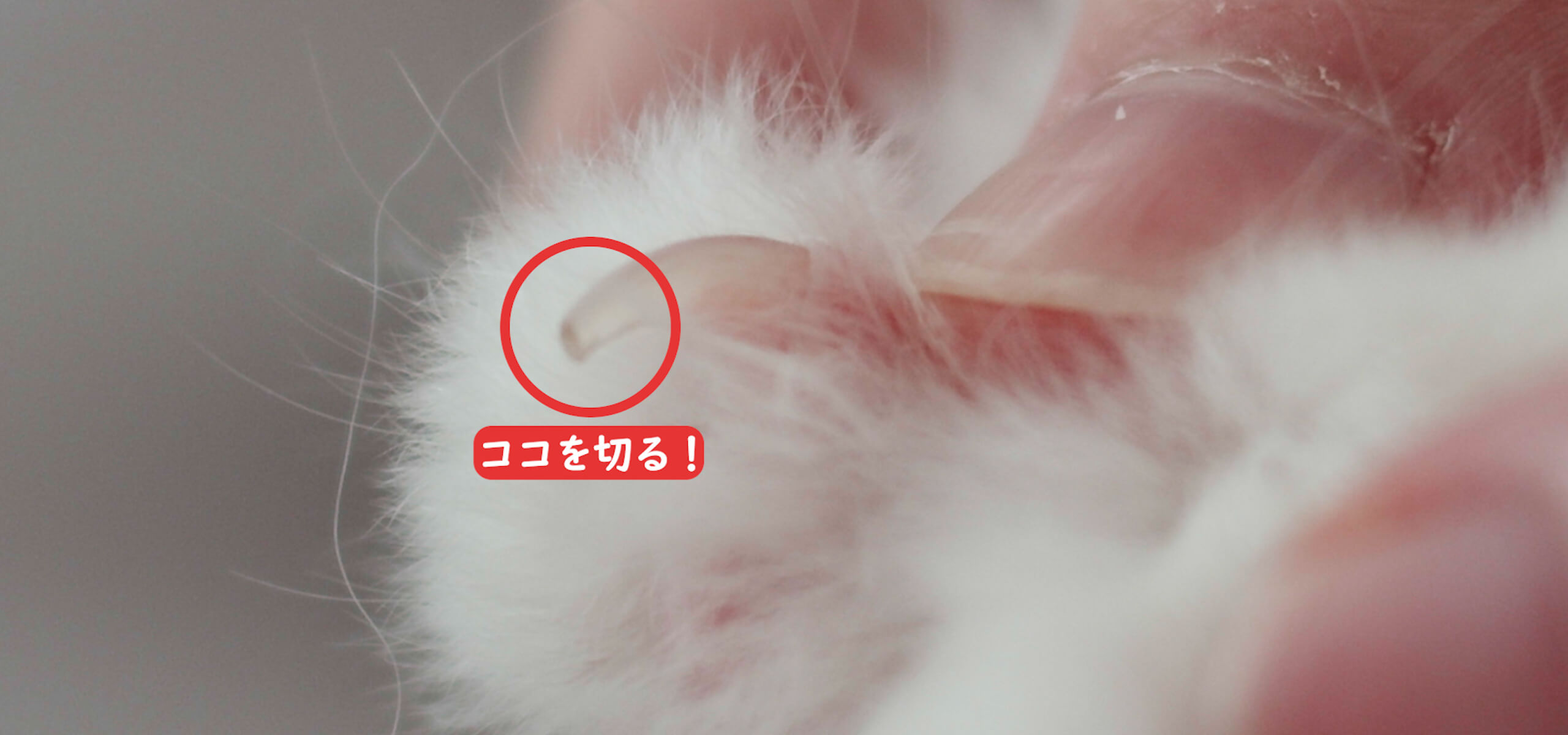
爪が透けてピンクに見える部分は「クイック(quick)」と呼ばれ、血管や神経が通っています。そこを避けて尖った先端部分を2~3mm程度カットします。ただし、爪が黒い猫は血管が見えませんので、特に注意が必要です。その場合は、肉球の高さを目安にし、カットする爪の長さを意識してください。
そして、万が一出血してしまった場合は、すぐに清潔なガーゼやコットンで押さえて止血します。しばらくしても血が止まらない場合は、動物病院に行きましょう。
5. 爪切りができたらご褒美のおやつをあげる
爪切りが終わったら、ご褒美のおやつを与えてたくさんほめてあげてください。爪切りが嫌なことではないというポジティブなイメージが猫の中でできると、次回からの爪切りがスムーズになるかもしれません。
6猫の爪切りはどのくらいの頻度がいい?
猫の爪切りは、どのくらいの頻度で行うのがいいのでしょうか。成猫、子猫、高齢の猫それぞれで、爪切りのタイミングには違いがあります。
成猫は3週間から1ヵ月に1回が目安
一般的に猫の爪切りは、生後1年以上経過している成猫であれば、3週間から1ヵ月に1回行うのが目安です。ただ、それぞれの猫の体調や活動量によって、爪の伸び方は違います。また、よく使う爪は伸びやすいともいわれています。爪の状態をこまめにチェックし、もし尖った爪があったらその都度切ってあげてください。
子猫は1~2週間くらいに1回のペースで
子猫は運動量が多いため、爪の伸びるスピードも段違いに早いです。ですから、目安としては1~2週間に1回くらいのペースで爪切りをしてあげましょう。
高齢の猫や爪とぎをあまりしない猫は、こまめにチェックして
高齢の猫や爪とぎをあまりしない猫は、古い爪がはがれず残りやすいため、爪が分厚くなってしまう傾向があります。2週間に1回を目安にこまめにチェックして、お手入れをしてあげてください。爪とぎの回数が減っている場合は、高齢以外の理由として病気やケガによる影響も考えられます。以前に比べて明らかに爪の伸び方が変わっている場合は、念のためかかりつけの動物病院に相談するとよいでしょう。
7猫の爪切りをスムーズに成功させるためのポイント
猫の爪切りを嫌がられずに成功させるためには、どうすればいいのでしょうか。続いては、爪切りのときに注意したいポイントをご紹介します。


猫の動きが活発な時間帯は避ける
猫が元気に遊んでいる時間帯は、爪切りをしないようにしましょう。活発に活動している時間帯は猫が興奮しやすく、無理に押さえつけてしまうと爪切りが嫌いになってしまいます。
もし、興奮して暴れてしまうようであれば、バスタオルや洗濯ネットで視界を遮ったり体を包み込んだりすると落ち着くことがあるのでおすすめです。あるいは、猫が寝ていて無防備な状態になっているところを狙って、爪切りをするのも手段のひとつです。
爪切りを始める直前にご褒美を与える
猫の機嫌があまり良くないときなどには、爪切りを始める前にも、お気に入りのフードやおやつなどのご褒美をあげるのがいいでしょう。リラックスし、気持ちがそれているタイミングで爪切りを始めるのがおすすめです。
1回の爪切りで全部の爪を切ろうとしない
猫が爪切りを嫌がるようであれば、一度に全部の爪を切らなくても構いません。猫が暴れることのないように、1日に1本か2本だけと決めて行ってもいいでしょう。猫と飼い主さんのペースで少しずつ慣れていきましょう。
普段から足をさわられることに慣れさせておく
爪切りでなくても、足をさわられることを嫌がる猫もいます。そのため、普段のスキンシップから足をさわられることに慣らしておくのがおすすめです。猫がさわられて喜ぶ首や背中、胸などをなでてあげながら、少しずつ足を揉んだり肉球にふれたりしてみてください。猫が機嫌良く足をさわらせてくれるようになったら、スムーズな爪切りに一歩近づくかもしれません。
8爪抜きは絶対にやってはダメ!
爪切りの手間を省くために爪を抜いてしまったほうが…という方がまれにいますが、これは絶対にやってはいけません。
爪の根元のピンクの部分には血管や神経が通っているため、もし爪を抜くと猫に激痛を与えてしまうことになります。それにより、ひどい痛みやストレスが生じ、排泄用の砂である猫砂をかけなくなったり、粗相をしたりといった問題行動を起こすきっかけになってしまいかねません。
そのため、いかなる場合であっても、絶対に爪抜きは行わないようにしましょう。
9どうしてもうまく爪が切れないときはどうする?
いろいろと準備をしても、猫がどうしても爪切りを怖がる場合など、爪切りをするのが難しいケースがあると思います。そのようなときの対応策について見ていきましょう。
自力で無理に行わず、プロに任せる
飼い主自身で猫の爪切りを行うのが難しい場合は、プロに任せてしまうのもひとつの方法です。嫌がる猫を飼い主が無理に押さえつけて爪切りをしたために、これまでせっかく築いた猫との信頼関係をなくしてしまうおそれもあります。
まずは、病院やトリマーに相談して爪切りをしてもらい、ゆっくりでもいいので、除々に自分でできるようになっていくといいでしょう。
電動爪やすり付きの猫用爪切りを使う
猫の爪の手入れをより手軽に安全に行うため、爪を切るのではなく爪を削るという選択肢もあります。例えば、電動爪やすりがついた爪切りであれば、深爪をすることなく爪先を簡単に丸く整えることができます。
爪切りの後の爪の角もなく、きれいなシルエットを保つことができるため、一石二鳥のアイテムといえるかもしれません。音に敏感な猫の場合はモーターや削る際に生じる音にびっくりすることがあるため、慎重にご使用ください。
10ペティオおすすめの爪切りグッズを紹介
猫の爪切りに使えるグッズには、どのような物があるのでしょうか。今回は、ペティオが販売しているおすすめの爪切りグッズを、2点ご紹介します。
おすすめ商品
11猫の爪切りをスムーズに行うには、入念な準備と猫との信頼関係が大切
安全・快適に過ごすためには必須の爪切りですが、猫が嫌がりがちなことでもあります。準備をしっかりして、慌てず落ち着いて行うことが大切です。
猫との信頼関係を築くことで、少しずつでもスムーズに爪切りができるようになるといいですね。
12
よくある質問
猫の爪切りQ&A
- 猫の爪切りをしないで伸ばしっぱなしにするとどうなる?
-
室内飼いの猫の爪を伸ばしっぱなしにすると、飼い主や同居の猫を傷つけてしまうおそれや、人が「猫ひっかき病(バルトネラ症)」や「パスツレラ症」といった感染症にかかるリスクもあります。その他にも、爪が伸びすぎて折れたり巻き爪状態になってしまい、猫自身も危険な状況に陥るおそれもあります。そのため、こまめにチェックして爪のケアをしてあげることが必要です。
- 猫の爪切りはどのくらいの頻度がいい?
-
成猫、子猫、高齢の猫それぞれで、爪切りのタイミングには違いがあります。成猫は3週間から1ヵ月に1回、子猫は1~2週間くらいに1回のペースで爪切りをしてあげましょう。高齢の猫や爪とぎをあまりしない猫は、こまめにチェックしてお手入れをしてあげてください。
- 猫の爪切りをスムーズに成功させるためには?
-
猫が元気に遊んでいる時間帯は、爪切りをしないようにしましょう。活発に活動している時間帯は猫が興奮しやすく、無理に押さえつけてしまうと爪切りが嫌いになってしまいます。猫の機嫌があまり良くないときなどには、爪切りを始める前にも、お気に入りのフードやおやつなどのご褒美をあげるのがいいでしょう。また、猫が爪切りを嫌がるようであれば、一度に全部の爪を切らなくても構いません。

